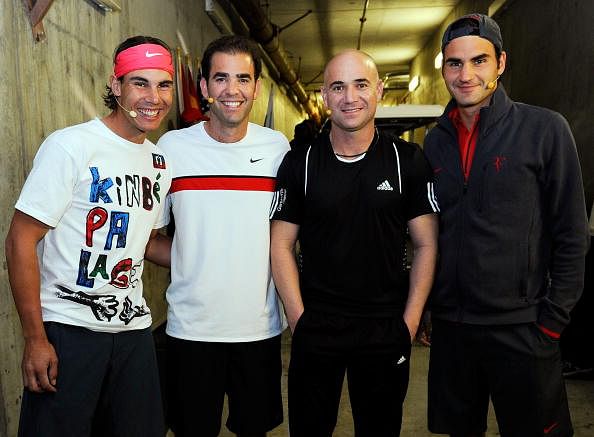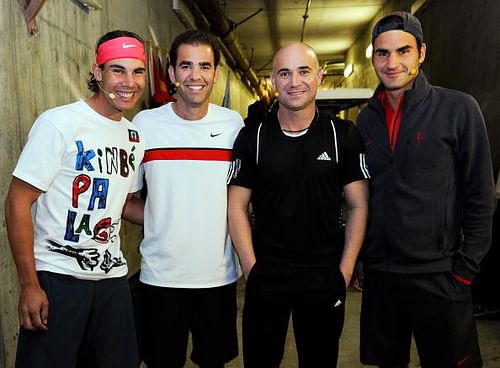
From Gonzales-Laver-Borg to Sampras-Federer-Nadal: Freak of history

In great company: Rafael Nadal, Pete Sampras, Andre Agassi and Roger Federer
Does history really repeat itself, or is that just another lame cliché that has been thrust upon us through no fault of ours? With Sportskeeda’s ‘Greatest tennis players of all time‘ series churning up one forgotten legend’s name after another, I was vaguely reminded of that saying. Initially, I couldn’t quite put my finger why; but as I took another look at the whole list, it struck me: history HAS repeated itself, at least as far as the greatest male tennis players of all time are concerned. If that sounds like Latin to you, then consider this: the six most impactful players in the history of men’s tennis have burst on the scene in two sets of three each, with a definite pattern surrounding not just the chronology of their dominance, but also their playing styles! I’m not one usually one to over-dramatize, but I would be lying if I said I didn’t get a few goosebumps while marveling at the freakiness of it all.
The player at the origin of this pattern, and also perhaps at the origin of overwhelmingly dominant tennis, is Pancho Gonzales. The American comes in at a lowly No. 16 in the list, but that has more to do with the lack of accurate records in tennis than with any shortcoming in his abilities or achievements. Gonzales was known for his fiery serve and forehand, as well as his indomitable will to win. On his day, Gonzales could make such fearsome use of these weapons that it was considered physically impossible to counter them. Gonzales rode these weapons to more than a decade of unchallenged dominance, and was only brought down to earth with the emergence of Open Era tennis and the arrival of Rod Laver.
Rocket Rod. A player who was less a player and more an artist; a magician. Laver could do anything. Power, touch, court smarts, vicious topspin, biting slice – they all combined to produce a game that was effective on every surface, against every kind of opponent. If ever there was an example of a game that was more than the sum of its parts, it had to be Laver’s. He may not have been the best in history at any one aspect of the game, but his lack of a discernible weakness ensured that he turned out to be, by far, the most successful player of his era; an era that included the likes of Pancho Gonzales, Ken Rosewall and Roy Emerson.
The next superstar after Laver was, of course, the Ice Man himself. Bjorn Borg took claycourt domination to heights never seen before, which would have been an incredible achievement on its own, except that Borg also took grasscourt domination to new heights during his reign. Borg carved out a career for the ages by relying on superlative defense and adaptability. There was no shot that Borg couldn’t get to on the court, and no surface-specific tweak that he couldn’t make to his game off the court. The result, as we all know, was a period of concentrated success (Borg won 11 of the 27 Majors that he entered) that will perhaps never be seen again.
Cut to a couple of decades later, and Pete Sampras was found to be tearing through the tour armed with two basic but devastating weapons: the big serve and big forehand. Does that remind you of anyone? Sampras was Pancho Gonzales re-incarnated, of course. After a decade of domination by the purely offensive-minded American came an artistic genius in the form of Roger Federer, who could seemingly do anything on the court with his exquisite skill and deft touch. Where had we seen that before? Where else but in the game of Rod Laver, who was one of the childhood idols of Federer. And before anyone could get too bored with the dominance of Federer, along came Rafael Nadal with his Borg-like defense and adaptive abilities to create his own awe-inspiring legacy.
So there you have it: two sets of all-time great players who arrived on the tennis scene in the same chronological order, but decades apart. The hard-serving Gonzales followed by the versatile Laver followed by Borg the untiring counterpuncher, and decades later, the big-serving Sampras followed by the versatile Federer followed by Nadal the baseliner extraordinaire. Of course, the change at the top wasn’t immediate in the case of the former trio; the Laver era began only around five years after the Gonzales era ended, while the Borg era took almost as much time to take shape once Laver had begun his decline. The Sampras-Federer-Nadal eras, on the other hand, were much more closely bunched together: Federer began his dominance barely a year after Sampras retired, while Nadal started making noise even before Federer’s glory years had ended. Still, the similarities in the succession of the tennis throne are unmistakable in these two periods.
Is there a reason why this pattern emerged two times over? Or is it all just a quirky coincidence? While it may be dangerous to go there, it is worthwhile to explore the possible technical causes of this phenomenon. Pure offensive tennis, the kind that Gonzales and Sampras championed, can be countered by very few things, and perhaps the most reliable of those counters is versatility. The best bet to defeat an irresistible power player is to throw him off his rhythm by introducing variations in pace and spin; Laver and Federer were both masterful exponents of precisely that. And how do you defeat a creative player who likes to constantly try out different things? By forcing him to do the same things over and over again, of course. Borg and Nadal were experts at getting every ball back in play and making their opponents hit an extra shot, inevitably coaxing out errors, and they were also adaptable enough to implement that game effectively across all surfaces.
If this pattern is anything to go by, the next all-time great player should be an all-or-nothing offensive player capable of bringing some serious heat with his serve as well as groundstrokes. But then how do we explain the whole Novak Djokovic situation?
Maybe all of this IS just a coincidence. A freaky, fascinating, fabulous one, but a coincidence just the same. Do coincidences repeat themselves too? It wouldn’t be such a bad thing if they did.